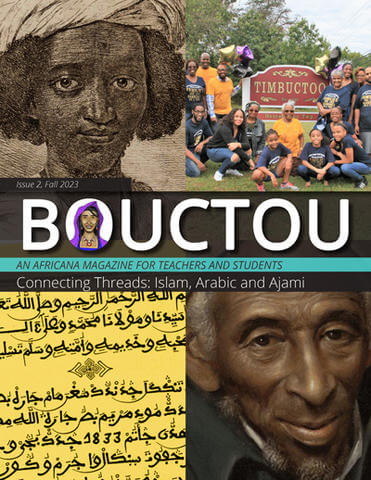Read the 2nd Issue of Bouctou!

Dive into our second issue of Bouctou, an Africana Magazine for Teachers and Students, which includes six articles with connecting threads to Islam, Muslims and Arabic.
Bouctou is published by the Outreach team at the Center for African Studies at Howard University. The vision behind the magazine is to create an accessible and appealing online resource for the K-12 classroom by providing informative articles, scholarly research and engaging commentary, and to support the curriculum by contributing quality Africa-focused resources and material. Bouctou issues also contain a student corner with activities and lesson ideas for students that are aimed to excite and inspire them to further explore the African world.
In the second issue, in Early West African Muslims in the U.S. and Mini-Bios of Enslaved Muslims, historian Sylviane Diouf notes the deep roots of Islam in Africa (beginning in the 8th century) and highlights literate West African Muslims who were kidnapped and enslaved in the U.S. Observers-of-the-day wrote about these enslaved Muslims, noting their devotion to Islam and that some were literate in Arabic. “Slaveholders, journalists, scholars, diplomats, writers, priests, and missionaries wrote about them. We also find their traces in runaway notices, newspaper articles, the Muslims’ own manuscripts, and their descendants’ memories (Diouf, 5).” Diouf provides samples of Arabic writings by enslaved Muslims Ayuba Diallo, Omar ibn Said, Bilali Muhammad and others.
We learned in the first issue of Bouctou that Timbuktu, Mali was the center of Islam and academic study in West Africa. In Timbuctoo, New Jersey: Rewriting Black History Guy Weston introduces the New Jersey settlement founded in 1826 by formerly enslaved Africans. Weston, a descendent of one of the early settlers, describes how he discovered his Timbuctoo heritage and his transformation into an amateur genealogist. The article also highlights community efforts to unearth archaeological evidence of Timbuctoo and teach local young people about the past. Guy Weston is particularly excited about the curriculum. “It’s important for young people in the area to learn about Timbuctoo, to connect to a history they can touch and feel…”
In Understanding Ajami: the Deep Roots of Islam and Arabic in Africa, Dr. Fallou Ngom of Boston University introduces us to Ajami, a writing system that modifies and enriches the Arabic script to write local languages, just as the Latin script has been modified to write French, Spanish, and German. Languages that currently utilize Ajami include Wolof, Hausa, Mandinka, Fula and more. Dr. Ngom’s research invites us to look closely at the writings of Muslims in West Africa and even Muslims enslaved in the U.S. for evidence of Ajami. Many scholars, he explains, have treated Ajami documents as undecipherable or poorly written Arabic because they simply don’t have the skills to decode the writing. At Boston University, Ngom and his team have amassed over 30,000 pages of Ajami documents in about ten languages. The documents cover a wide variety of topics, work songs, poems and prose text, theology, astrology, politics and more.
Bouctou’s “Student Corner” concludes the issue with Brenda Randolph's article, Ajami an Article for Students and a lesson plan for teachers by Dr. Elsa Wiehe, What is Ajami? Where is it Used? How can I write with it? Wiehe’s lesson provides a video that demonstrates how to write in Wolof Ajami. We invite you to explore this issue and share it with your colleagues and students.
